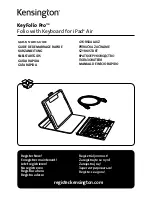
Do not operate the teach-in buttons using sharp objects. We recommend placing the
switching range in the object, e.g., see Graphic F. Once the sensing range has been
adjusted, the object is removed from the path of the beam, which causes the back‐
ground to be suppressed and the switching output to change (see Graphic C).
The sensor is adjusted and ready for operation. Refer to Graphic C to check the func‐
tion. If the switching output fails to behave in accordance with Graphic C, check the
application conditions. See section
.
Q1
Q2
Q3
Figure: F
Q (PNP)
Q (NPN)
L
L
D
D
1
0
1
0
1
0
1
0
Figure: C
4.2
Setting the switching outputs and other sensor configurations via the menu
As an alternative, the switching outputs can also be set via the menu. Further sensor
configurations can also be performed via the menu. The menu is accessed by briefly
pressing the
Set/Q3
button for < 1 s. Graphic K describes how to navigate within the
menu.
4
CONFIGURATION
8
8020034.17U4 | SICK
Subject to change without notice










































